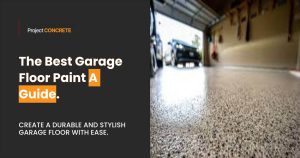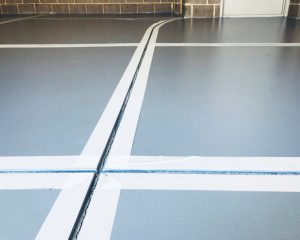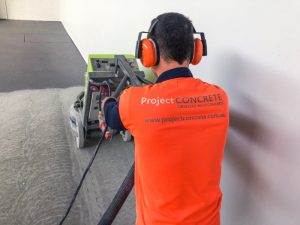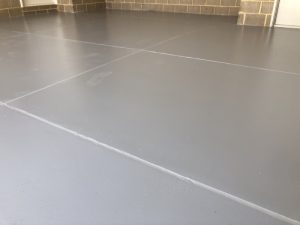
Need the best garage floor paint? This guide explores top options like epoxy, acrylic, and polyurethane, and offers tips for choosing the right one. Discover what makes a paint the best for your garage.
Understanding Garage Floor Paint
When your garage flooring options, it’s essential to recognize that not all floor coatings are created equal. While epoxy floor coatings are often lauded for their strength and resistance to the heavy toll of garage life—think skidding tires and packed SUVs—traditional garage floor paint provides a different level of resilience. Understanding the distinction between epoxy paint and other types of floor paint is crucial as they cater to different needs and applications.
Despite some misconceptions, it’s important to note that floor paint doesn’t provide the same form of impenetrable protection as some of the other coatings available on the market. Nevertheless, floor paint still offers a barrier against stains, moisture, and abrasions and remains a cost-effective and accessible option for many homeowners looking to enhance their garage floors.

Top Choices for the Best Garage Floor Paint
Embarking on the journey to refresh your garage’s floor, you’re faced with a plethora of choices. Among the frontrunners are the robust epoxy coatings, the user-friendly acrylic floor paints, and the resilient polyurethane paints, each bringing its unique set of advantages to your garage floors.
Let’s delve into these options to help you navigate the sea of possibilities and select the best floor paint that meets your garage’s demands.
Epoxy Floor Paint
Renowned for its remarkable toughness and ability to repel chemical spills, epoxy floor paint is a heavyweight champion in the arena of garage floor coatings. Its robust adhesion and resistance to abrasions make it an ideal choice for both residential garages and commercial spaces alike, providing a level of durability that accommodates the rigorous demands of heavy traffic and frequent use.
Benefits of epoxy flooring include:
- Waterproof nature
- Resilience against heavy traffic
- Easy to clean and maintain
- Available in a variety of colours and finishes
- Can be customized with decorative flakes or patterns
While epoxy flooring is celebrated for its many benefits, it’s worth mentioning that prolonged sun exposure could lead to some yellowing over time, a small caveat in an otherwise impressive list of benefits.
Moreover, the protective qualities of epoxy floor coatings extend beyond mere aesthetics; they offer a fortress-like barrier against heat, UV rays, and bacteria, making them a favourite for industrial settings as well. For those looking to combine functionality with style, epoxy floor coating can be mixed with decorative flakes that not only conceal oil stains and dirt but also elevate the visual appeal of the finished floor.
Acrylic Floor Paint
If you’re after a budget-friendly solution that promises a straightforward application, acrylic floor paint might just be your ally. Its reputation for affordability and user-friendliness makes it a popular contender for DIY enthusiasts eager to take on a weekend project. The quick-drying nature of the paint allows for a rapid transformation of your garage, minimizing downtime and inconvenience.
However, it’s important to keep in mind that the ease of use comes at the cost of longevity; acrylic floor paint may not hold up as well as other options in the face of high-traffic and demanding garage activities.
Polyurethane Floor Paint
Climbing the ladder of sophistication, polyurethane floor paint stands out with its exceptional features:
- Chemical resistance
- UV protection, ensuring that your garage floor remains unfazed by the harsh rays of the sun
- Holds up against the test of time
- Imbues your space with a high-gloss finish that can make any garage look sleek and professional.
Its strength in sealing decorative elements, like colour flakes (flake flooring) and natural stone, combined with its non-yellowing properties, makes it an enduring choice for those wanting to maintain a pristine appearance in their garage for years to come. With a large range of applications, it’s a versatile solution for various needs.

Key Factors in Choosing the Best Garage Floor Paint
Selecting the best garage floor paint is not merely a matter of personal preference. It’s about understanding the specific demands of your space and matching those needs with the right product. Consider the type of usage your garage will endure—will it be a bustling workshop or just a spot for your vehicle? The local climate, which can greatly influence the performance of certain coatings, also plays a pivotal role in your decision-making process.
Additionally, think about the maintenance each type of paint requires and, of course, weigh the initial installation costs against the long-term value they may provide.
Durability
Durability is a cornerstone when it comes to garage floor coatings. High-traffic areas, such as garages, demand a product that can endure the daily onslaught of tires, tools, and toil. While latex acrylic paint is designed to brave skidding tires and heavyweight vehicles, it does not offer the same level of enduring protection as its epoxy and polyurethane counterparts.
Epoxy floor coatings, in particular, are a fortress against chemical spills and can remain intact for years, safeguarding your floor against oil and water damage. On the other side of the spectrum, acrylic paint, though pocket-friendly, may not be your best bet if your garage sees a lot of action, as it tends to chip and lacks robust adhesion to non-porous surfaces like concrete.
The durability of your chosen coating not only impacts the longevity of your floor but also affects the frequency and cost of maintenance down the line.
Ease of Application
Ease of application is another critical factor to contemplate. For those taking a do-it-yourself approach, the simplicity with which acrylic floor paint can be applied is certainly appealing. Its rapid drying time allows you to complete your project swiftly, with less waiting around for paint to dry.
Though applying polyurethane coatings might require a steadier hand due to their thicker consistency and longer drying times, the result can be well worth the extra effort if durability is a priority. Regardless of the type of paint, remember that the quality of the finished floor is heavily influenced by how well the surface has been prepared and the paint applied.
Cost-Effectiveness
In the world of home improvements, cost-effectiveness is often king. While it’s tempting to opt for the cheapest option upfront, it pays to consider the longevity and maintenance requirements of your chosen garage floor paint. High-quality coatings may come with a steeper initial price tag, but their resistance to wear and tear means fewer touch-ups and a longer lifespan for your floor.
These coatings not only save you money over time by reducing the need for frequent repairs but also save you the hassle of having to periodically redo your garage floor. It’s a balancing act between upfront costs and the benefits you’ll reap in the long run.

How to Prepare Your Garage Floor for Painting
The secret to a lasting and effective garage floor paint job lies in the preparation. It’s the unsung hero that determines whether your paint will triumphantly adhere or sadly succumb to peeling and chipping.
Whether you’re opting for a sturdy epoxy coating or another type of coating, the surface demands thorough preparation to ensure a finish that is both durable and visually pleasing.
Cleaning the Surface
First and foremost, cleaning the surface is non-negotiable. You’ll want to:
- Sweep away any dust, dirt, and debris before tackling the tougher stains.
- Apply a degreaser and scrub until grease and oil marks surrender.
- Rinse the floor thoroughly with a hose or pressure washer, ensuring all traces of the cleaning agents are washed away.
It’s crucial to perform a water droplet test to check for any remaining sealants that could hinder the paint’s bonding to the concrete. If the water beads up, more cleaning is needed; if it’s absorbed, your floor is ready for the next steps.
Repairing Cracks and Holes
With a clean slate, turn your attention to the floor’s battle scars. Cracks and holes can undermine the smoothness of your finished floor, so it’s imperative to fill them with high-quality materials. Concrete resurfacers—a blend of sand, Portland cement, and polymers—are your allies here, providing a fortified mixture to mend the concrete’s imperfections.
Don’t overlook any gaps between the floor and skirting; they too need sealing with the right caulking materials to ensure a complete and uniform surface.
Priming the Floor
Once repairs are made, it’s time to prime. Priming serves as the bridge between your concrete and the paint, filling any remaining imperfections and ensuring a strong bond. Applying a concrete and masonry bonding primer will provide the grip needed for the paint to hold fast to uncoated surfaces.
This step is essential, as it not only aids in adhesion but also contributes to the longevity and resilience of your paint job.

Tips for Applying Garage Floor Paint
With your prep work complete, the stage is set for the main event: applying the garage floor paint. To achieve that professional-looking finish, there are a few key tactics to keep in your arsenal.
From choosing the right tools to timing the application just right, these tips will help you navigate the painting process with confidence.
Tools You Will Need
Before you start rolling out your chosen paint or epoxy, make sure you have the necessary kit. Here are the essential tools you’ll need:
- Broom and wet-dry vacuum to clear any residual dust
- Paintbrush and paint roller with covers for the application process
- Grinder or sander (if working with a smooth surface) to roughen it up, ensuring the paint has something to grip onto.
After applying the first coat, switch to a paintbrush to work the product into the surface, getting into every nook and cranny for thorough coverage. Once this is done, apply the top coat to ensure a durable and long-lasting finish.
Step-by-Step Painting Process
Mixing the paint or epoxy according to the manufacturer’s instructions is the first critical step in the painting process. Pay close attention to mixing times to ensure a consistent finish.
Apply the product in manageable square meter sections to maintain an even coat throughout the entire garage floor. Keep the area well-ventilated to help clear the strong odors that can accompany some garage floor paints and epoxies, and follow the instructions carefully.
Curing Time and Maintenance
Patience is a virtue, especially when it comes to the curing time of your garage floor paint. Depending on the type of paint and the ambient temperature, this can vary. In general, expect to wait about 72 hours before the initial drying is complete. Polyurethane coatings often cure faster than their counterparts, which can be a significant advantage for those needing a quick turnaround.
For latex paints, while they may dry to the touch within hours, it’s wise to give them at least a full day before walking on them and a full week before reintroducing your vehicle to its home. To ensure the paint has fully hardened, avoid driving on newly painted or epoxied floors for at least 10 days. Once cured, keep your garage floor looking its best by cleaning any spills immediately and using mats or rugs in high-traffic areas to minimize wear and tear.
Common Mistakes to Avoid When Painting Garage Floors
Even with the best intentions, mistakes can happen. One of the most common pitfalls is applying the coating too thinly, which compromises both protection and coverage. Using improper tools or techniques can result in an unsatisfactory finish and may even damage the floor, so always follow the manufacturer’s instructions and use the recommended equipment.
Failing to apply a sealant leaves the door open for moisture, stains, and fading to damage your freshly painted surface. And remember, safety first—protective gloves are a must to prevent skin contact with the paint or epoxy.
Enhancing Visual Appeal with Garage Floor Paint
The beauty of garage floor paint extends beyond its utilitarian function; it’s also a powerful tool for augmenting the aesthetic allure of your space. A spectrum of colors and finishes are at your disposal, allowing for a tailored look that complements your home’s exterior and personal taste. Consider the impact of color: dark hues like slate or black not only look sleek but are also practical, effectively hiding tire marks and grease stains.
Alternatively, lighter and neutral shades can brighten a dimly lit garage and create the illusion of a more spacious environment. For a more dynamic and textured appearance, multi-colored decorative flakes can be incorporated into epoxy coatings, offering design flexibility and an added dimension to your garage floors. Ultimately, the key to enhancing the visual appeal of your garage lies in selecting the right paint that not only performs well but also aligns with your stylistic preferences.
Comparing Garage Floor Paints to Other Coating Options
While garage floor paints are a popular choice for many homeowners, it’s important to consider how they stack up against other flooring options. For those looking for a quick and economical solution, vinyl flooring is an attractive option, though it may not hold up as well over time, necessitating more frequent replacements. On the other hand, polished concrete offers a cost-effective and durable alternative that boasts hypoallergenic properties, suitable for a wide range of environments.
Interlocking garage floor tiles provide ease of installation and material variety, but they may not fare as well under direct sunlight. For an eco-friendly and robust solution, rubber flooring presents a compelling case, albeit with a higher upfront cost. Delving deeper into professional-grade materials, polyaspartic floor coatings, such as the FloortexTM brand, offer unparalleled protection against water, chemicals, and wear, although they require specialized equipment for application.
If aesthetics are your primary concern, floor stains can add a decorative touch to your garage, but keep in mind they offer little in the way of protection. When weighed against these alternatives, it becomes clear that the right choice for your garage floor depends on a blend of factors including durability, cost, and the visual impact you desire to achieve.
Summary
Navigating the world of garage floor coatings can be daunting, but with the right information and careful consideration, you can make a choice that stands the test of time and use. From the unparalleled durability and chemical resistance of epoxy coatings to the easy application and affordability of acrylic paint, and the glossy, UV-protected finish of polyurethane, there’s a solution for every garage’s needs. Remember, the key to a successful application lies in thorough preparation, careful application, and patience during curing. By avoiding common pitfalls and selecting a paint that not only strengthens but also beautifies your garage floor, you’ll create a space that’s both functional and inviting. Let your garage be a reflection of your home’s pride and your commitment to quality.
